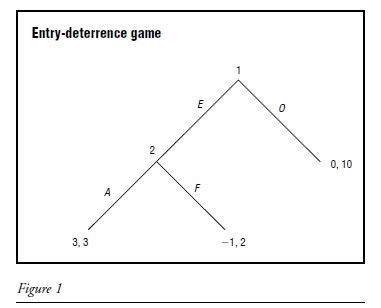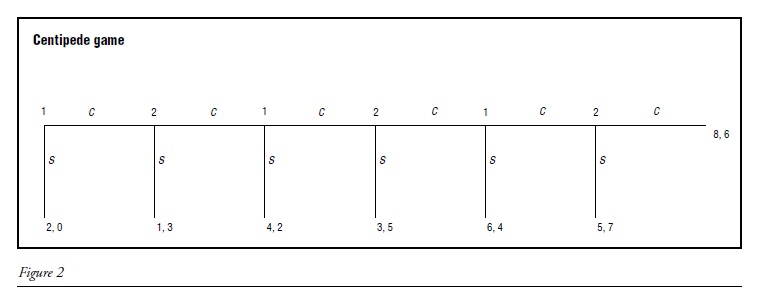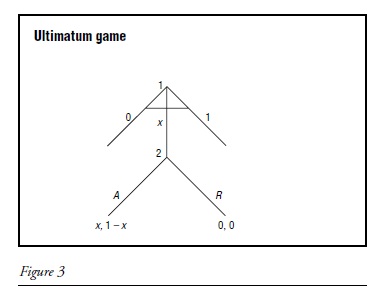This sample Subgame Perfection Research Paper is published for educational and informational purposes only. If you need help writing your assignment, please use our research paper writing service and buy a paper on any topic at affordable price. Also check our tips on how to write a research paper, see the lists of research paper topics, and browse research paper examples.
In a Nash equilibrium strategy profile, every player plays the best response against the other players’ strategies specified in the profile. For extensive form games where players move sequentially, one may use this notion, treating players’ strategies as complete plans of action before the play begins. However, this concept ignores the sequential structure, and hence, sometimes may not be justifiable.
Consider the entry-deterrence game in Figure 1, in which there are two firms (players): a possible entrant (player 1) to an industry in which there is an incumbent (player 2). The potential entrant moves first and has two choices—to enter (E) or to stay out (O). If player 1 does not enter, the game ends. If player 1 enters, the incumbent then has two options—to accommodate (A) or to fight (F ).
The game in Figure 1 has two Nash equilibria: (O, F ) and (E, A). Indeed, in the equilibrium profile (O, F ), the entrant is playing the best response O, because the entrant believes that the incumbent will choose F. However, this belief is based on an incredible threat. F is not optimal in the unreached subgame (intuitively, the “game” below a nonterminal node) in which the incumbent has to make a choice (the incumbent does not make a choice when the entrant chooses O because the game ends).
A subgame perfect equilibrium (SPE), as defined by Reinhard Selten (1965), is a strategy profile that induces a Nash equilibrium in every subgame of the original game, even if it is off the equilibrium path. Clearly, SPE refines the set of Nash equilibria. In the above example, (E, A) is a SPE, while (O, F) is not.
Any finite extensive form game with perfect information is solved using backward induction. Backward induction finds the optimal actions of the players in the “last” subgame first, and then, given these actions, works backward to the beginning to find the SPE of the game.

Figure 1
 Figure 2
Figure 2
Consider the two-player “centipede” game in Figure 2, in which each player sequentially chooses either to continue (C) or to stop (S). Backward induction implies that the unique SPE is S for both players in every stage.
The backward induction solution is not observed in experiments where the players continue the game for a few stages (McKelvey and Palfrey 1992). This finding questions whether rational players follow backward induction. Robert Aumann (1995), however, proved that “common knowledge of rationality” implies backward induction.
Another criticism of SPE comes from the experiments on the ultimatum game, as in Figure 3, in which player 1 offers a fraction (x) of a pot of money to player 2, who has a choice to accept (A) or to reject (R).
The SPE outcome is for player 1 to offer the smallest money unit (say, 1 c) and for player 2 to accept it. However, in experiments, offers are about 40 percent, and low offers are rejected (Guth et al. 1982). This is a violation of SPE only if we assume that the players care only about money. One may, however, test the outcomes using revealed preferences in games (Ray and Zhou 2001).
 Figure 3
Figure 3
For games with imperfect information, subgame perfection is not enough to justify a solution. One should consider sequential equilibrium (Kreps and Wilson 1982).
Bibliography:
- Aumann, Robert J. 1995. Backward Induction and Common Knowledge of Rationality. Games and Economic Behavior 8: 6–19.
- Guth, Werner, Rolf Schmittberger, and Bernd Schwarze. 1982. An Experimental Analysis of Ultimatum Bargaining. Journal of Economic Behavior and Organization 3: 367–388.
- Kreps, David M., and Robert B. Wilson. 1982. Sequential Equilibria. Econometrica 50: 863–894.
- McKelvey, Richard D., and Thomas R. Palfrey. 1992. An Experimental Study of the Centipede Game. Econometrica 60: 803–836.
- Ray, Indrajit, and Lin Zhou. 2001. Game Theory via Revealed Preferences. Games and Economic Behavior 37: 415–424.
- Selten, Reinhard. 1965. Spieltheoretische Behandlung eines Oligopolmodells mit Nachfragetragheit. Zeitschrift fur die Gesamte Staatswissenschaft 121: 301–324, 667–689.
See also:
Free research papers are not written to satisfy your specific instructions. You can use our professional writing services to buy a custom research paper on any topic and get your high quality paper at affordable price.





